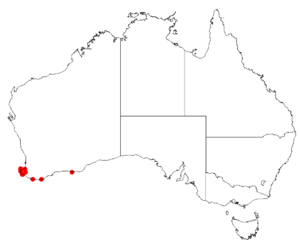Boronia anceps facts for kids
Quick facts for kids Boronia anceps |
|
|---|---|
| Conservation status | |
| Scientific classification | |
 |
|
| Occurrence data from Australasian Virtual Herbarium |
Boronia anceps is a special plant that belongs to the citrus family, called Rutaceae. It only grows in a small part of Western Australia, in the south-west. This plant is a perennial herb, which means it lives for more than two years. It has small leaves and pretty pink flowers with four petals.
Contents
What Does Boronia anceps Look Like?
This plant is a perennial herb. It can grow up to 60 cm (20 in) tall. It has flat stems and does not have a special woody base called a lignotuber.
Its leaves are narrow and shaped like an egg or a long oval. They are about 20 mm (0.8 in) long. The leaves closer to the top of the plant are much smaller.
The flowers are pink or a mix of pink and purple. They grow in groups at the very tip of the stems. These groups of flowers sit on a thin stalk, or peduncle, which can be up to 60 mm (2 in) long. Each single flower has its own small, thin stem, called a pedicel, about 5–10 mm (0.2–0.4 in) long.
Each flower has four dark red sepals. Sepals are like small leaves that protect the flower bud. These sepals are narrow and triangular, or broadly egg-shaped, and are about 2–4 mm (0.08–0.2 in) long. The four pink petals are broadly egg-shaped and about 8 mm (0.3 in) long. Their bases overlap each other. The plant flowers from September to December or January.
How Was Boronia anceps Named?
The plant Boronia anceps was officially described in 1998. It was named by a scientist named Paul G. Wilson. He published his description in a science journal called Nuytsia.
The first plant specimen was found near a crossing on the Scott River, close to Augusta. The second part of its scientific name, anceps, is a Latin word. It means "two-sided," which describes the flat shape of the plant's stem.
Where Does Boronia anceps Live?
This special boronia plant grows in areas that are swampy during certain times of the year. It likes to live in a type of shrubland called heath.
It is only found in a specific region of Western Australia. This area is located between the Scott River and Walpole.
Is Boronia anceps Protected?
The Government of Western Australia's Department of Parks and Wildlife keeps track of rare plants. They have classified Boronia anceps as "Priority Two".
This means that we don't know a lot about this plant yet. It has only been found in a few places. However, it is not currently in immediate danger of disappearing.


